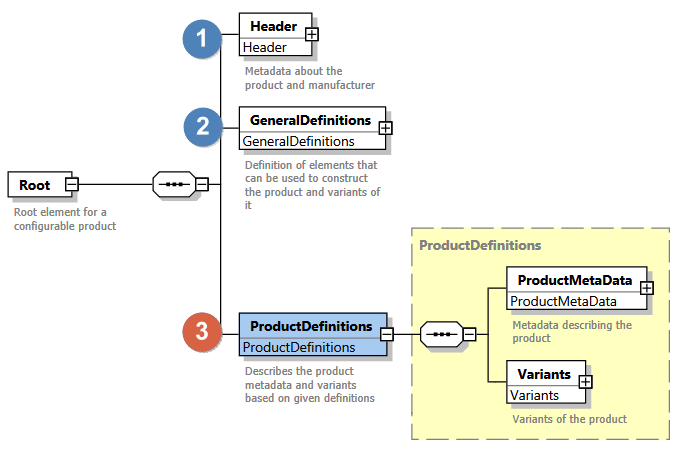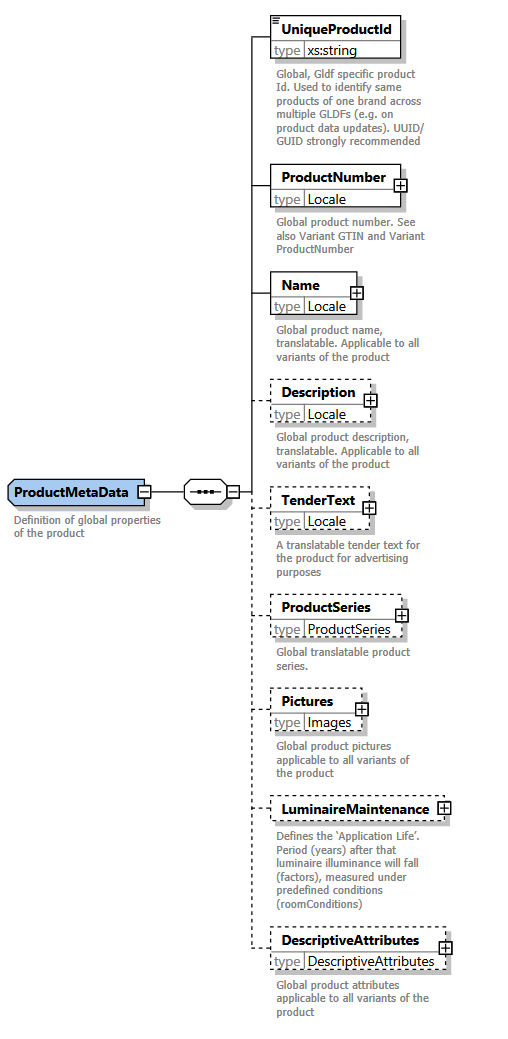Global Product Data
ProductDefinitions Description
After the Header (1) and GeneralDefinitions (2) elements have beed defined, the actual product description in form of a third Root child element named ProductDefinitions (3) element can follow now:

It consists of two child elements
- Exactly 1
ProductMetaDataXML element, discussed in this chapter - 1-n
VariantXML elements, discussed in the next chapter
For a valid luminaire description, one ProductMetaData and at least one Variant element are mandatory. But what is the difference?
ProductMetaData ⇄ Variants
Both elements holds marketing information about the luminaire on the one hand. Like product name and number, description texts in multiple languages, product images or the categorisation of the lumianire in product series. As well as a lot of further descriptive attributes like housing colors, ik rating or the ATEX directive where applicable.
And technical information such as the mounting point of the luminaire, maintenance recommendations or the most important: a reference to the previously defined Geometries and Emitters.
The differences between ProductMetaData and Variant are as follows
- A GLDF can only contain one
ProductMetaDatabut multipleVariant - The child elements of
ProductMetaDatadefine global properties of the luminaire - The child elements of
Variantdefine specific properties of the variants of a luminaire - Some properties are childs of only one of the elements. The maintenance recommendations can only be found on
ProductMetaDatafor example. The GTIN on the other hand has to be defined for eachVariant - For child elements with the same name on both,
ProductMetaDataandVariant, applies: if both are defined,VariantoverwritesProductMetaData. This is important to understand and therefore explained in detail below.
Most marketing information are optional. However, the more are specified, the better users can work with the GLDF.
ProductMetaData XSD description

XML example
ProductMetaData is a relatively straightforward element and in its simplest form only requires three mandatory fields: An unique product id, the product number and the product name in one language (preferably English):
<?xml version="1.0" encoding="UTF-8"?>
<Root xmlns:xsi="http://www.w3.org/2001/XMLSchema-instance"
xsi:noNamespaceSchemaLocation="https://gldf.io/xsd/gldf/1.0.0-rc.3/gldf.xsd">
<Header>
<!--Skipped for clarity-->
</Header>
<GeneralDefinitions>
<!--Skipped for clarity-->
</GeneralDefinitions>
<ProductDefinitions>
<ProductMetaData>
<UniqueProductId>e1da63af-6e41-45ff-927b-d66f91d6b447</UniqueProductId>
<ProductNumber>
<Locale language="en">1234-AB</Locale>
</ProductNumber>
<Name>
<Locale language="en">My luminaire</Locale>
</Name>
</ProductMetaData>
<Variants>
<!--Skipped for clarity-->
</Variants>
</ProductDefinitions>
</Root>
The element UniqueProductId is particularly important, as it makes it possible to recognise the same (updated) product across multiple GLDF files. You could use the product's article number, GTIN or EAN for it, but we recommend UUIDs (GUIDs) related only for this use case, since all other values could change over time.
See also Unique IDs
A complete example, on the other hand, could look as follows. In general, it is recommended to provide as much information about the product as possible:
<?xml version="1.0" encoding="UTF-8"?>
<Root xmlns:xsi="http://www.w3.org/2001/XMLSchema-instance"
xsi:noNamespaceSchemaLocation="https://gldf.io/xsd/gldf/1.0.0-rc.3/gldf.xsd">
<Header>
<!--Skipped for clarity-->
</Header>
<GeneralDefinitions>
<!--Skipped for clarity-->
</GeneralDefinitions>
<ProductDefinitions>
<ProductMetaData>
<UniqueProductId>e1da63af-6e41-45ff-927b-d66f91d6b447</UniqueProductId>
<ProductNumber>
<Locale language="en">1234-AB</Locale>
</ProductNumber>
<Name>
<Locale language="en">My luminaire</Locale>
<Locale language="de">Meine Leuchte</Locale>
</Name>
<Description>
<Locale language="en">Wall-mounted, dimmable luminaire with rotatable joints</Locale>
<Locale language="de">Dimmbare Leuchte mit drehbaren Gelenken in Wandmontage</Locale>
</Description>
<TenderText>
<Locale language="en">Our bestseller, winner of the Red Dot Award</Locale>
<Locale language="de">Unser Verkaufsschlager, Gewinner des Red Dot Awards</Locale>
</TenderText>
<ProductSeries>
<ProductSerie id="familyXY">
<Name>
<Locale language="en">Product family XY</Locale>
<Locale language="de">Produktfamilie XY</Locale>
</Name>
</ProductSerie>
<ProductSerie id="familyYZ">
<Name>
<Locale language="en">Our series YZ</Locale>
<Locale language="de">Unsere Serie YZ</Locale>
</Name>
</ProductSerie>
</ProductSeries>
<Pictures>
<Image fileId="pictureFile1" imageType="Product Picture" />
<Image fileId="pictureFile2" imageType="Application Picture" />
<Image fileId="pictureFile3" imageType="Technical Sketch" />
<Image fileId="pictureFile4" imageType="Other" />
</Pictures>
<LuminaireMaintenance>
<Cie97LuminaireType>Dust Proof IP5X</Cie97LuminaireType>
<CieLuminaireMaintenanceFactors>
<LuminaireMaintenanceFactor years="1" roomCondition="Normal">0.9</LuminaireMaintenanceFactor>
<LuminaireMaintenanceFactor years="2" roomCondition="Normal">0.8</LuminaireMaintenanceFactor>
<LuminaireMaintenanceFactor years="3" roomCondition="Normal">0.6</LuminaireMaintenanceFactor>
</CieLuminaireMaintenanceFactors>
</LuminaireMaintenance>
<DescriptiveAttributes>
<!-- see documentation for DescriptiveAttributes-->
</DescriptiveAttributes>
</ProductMetaData>
<Variants>
<!--Skipped for clarity-->
</Variants>
</ProductDefinitions>
</Root>
An introduction to DescriptiveAttributes can be found here.
Luminaire maintenance
There are several options for specifying the maintenance properties of a luminaire:
Cie97LuminaireTypeacording to the CIE 97 standardCieLuminaireMaintenanceFactorsacording to CIE Luminaire Maintenance Factor standard (LMF)IesLuminaireLightLossFactorsaccording to IES Light Loss Factor standard (LLF)JiegMaintenanceFactorsaccording to the Japanese maintenance factor method JIEG-001
It is possible to define one or several types.
Cie97LuminaireType
The luminaire maintenance according to CIE 97 is indicated by specifying a luminaire type. For each type a cleaning schedule/interval presets is specified in this standard. Possible types are:
Bare BattenOpen Top Housing (Natural Ventilated)Closed Top Housing (Unventilated)Enclosed IP2XDust Proof IP5XEnclosed Indirect (Uplight)Airhandling, Forced Ventilated
<?xml version="1.0" encoding="UTF-8"?>
<Root xmlns:xsi="http://www.w3.org/2001/XMLSchema-instance"
xsi:noNamespaceSchemaLocation="https://gldf.io/xsd/gldf/1.0.0-rc.3/gldf.xsd">
<Header>
<!--Skipped for clarity-->
</Header>
<GeneralDefinitions>
<!--Skipped for clarity-->
</GeneralDefinitions>
<ProductDefinitions>
<ProductMetaData>
<UniqueProductId>e1da63af-6e41-45ff-927b-d66f91d6b447</UniqueProductId>
<ProductNumber>
<Locale language="en">42</Locale>
</ProductNumber>
<Name>
<Locale language="en">My luminaire</Locale>
</Name>
<LuminaireMaintenance>
<Cie97LuminaireType>Dust Proof IP5X</Cie97LuminaireType>
</LuminaireMaintenance>
</ProductMetaData>
<Variants>
<!--Skipped for clarity-->
</Variants>
</ProductDefinitions>
</Root>
CieLuminaireMaintenanceFactors
Luminaire maintenance acording to CIE LMF allows the specification of a maintenance factor (lumen degradation due to pollution) for different room conditions and years, that have past
<?xml version="1.0" encoding="UTF-8"?>
<Root xmlns:xsi="http://www.w3.org/2001/XMLSchema-instance"
xsi:noNamespaceSchemaLocation="https://gldf.io/xsd/gldf/1.0.0-rc.3/gldf.xsd">
<Header>
<!--Skipped for clarity-->
</Header>
<GeneralDefinitions>
<!--Skipped for clarity-->
</GeneralDefinitions>
<ProductDefinitions>
<ProductMetaData>
<UniqueProductId>e1da63af-6e41-45ff-927b-d66f91d6b447</UniqueProductId>
<ProductNumber>
<Locale language="en">42</Locale>
</ProductNumber>
<Name>
<Locale language="en">My luminaire</Locale>
</Name>
<LuminaireMaintenance>
<CieLuminaireMaintenanceFactors>
<LuminaireMaintenanceFactor years="1" roomCondition="Very Clean">0.99</LuminaireMaintenanceFactor>
<LuminaireMaintenanceFactor years="1" roomCondition="Clean">0.95</LuminaireMaintenanceFactor>
<LuminaireMaintenanceFactor years="1" roomCondition="Normal">0.91</LuminaireMaintenanceFactor>
<LuminaireMaintenanceFactor years="1" roomCondition="Dirty">0.82</LuminaireMaintenanceFactor>
<LuminaireMaintenanceFactor years="2" roomCondition="Very Clean">0.96</LuminaireMaintenanceFactor>
<LuminaireMaintenanceFactor years="2" roomCondition="Clean">0.92</LuminaireMaintenanceFactor>
<LuminaireMaintenanceFactor years="2" roomCondition="Normal">0.85</LuminaireMaintenanceFactor>
<LuminaireMaintenanceFactor years="2" roomCondition="Dirty">0.74</LuminaireMaintenanceFactor>
</CieLuminaireMaintenanceFactors>
</LuminaireMaintenance>
</ProductMetaData>
<Variants>
<!--Skipped for clarity-->
</Variants>
</ProductDefinitions>
</Root>
IesLuminaireLightLossFactors
Luminaire maintenance acording to IES LLF is similar to CIE LMF. Its again the ratio of illuminance for a given area to the value that would occur if lamps operated at their initial rated lumens. In comparison, the element is only named differently and now called LuminaireDirtDepreciation. As well as the description of the room characteristic is minimally different: The specification Normal in the CIE standard is now called Moderate. And an additional room condition Very Dirty is possible.
<?xml version="1.0" encoding="UTF-8"?>
<Root xmlns:xsi="http://www.w3.org/2001/XMLSchema-instance"
xsi:noNamespaceSchemaLocation="https://gldf.io/xsd/gldf/1.0.0-rc.3/gldf.xsd">
<Header>
<!--Skipped for clarity-->
</Header>
<GeneralDefinitions>
<!--Skipped for clarity-->
</GeneralDefinitions>
<ProductDefinitions>
<ProductMetaData>
<UniqueProductId>e1da63af-6e41-45ff-927b-d66f91d6b447</UniqueProductId>
<ProductNumber>
<Locale language="en">42</Locale>
</ProductNumber>
<Name>
<Locale language="en">My luminaire</Locale>
</Name>
<LuminaireMaintenance>
<IesLuminaireLightLossFactors>
<LuminaireDirtDepreciation years="1" roomCondition="Very Clean">0.99</LuminaireDirtDepreciation>
<LuminaireDirtDepreciation years="1" roomCondition="Clean">0.98</LuminaireDirtDepreciation>
<LuminaireDirtDepreciation years="1" roomCondition="Moderate">0.95</LuminaireDirtDepreciation>
<LuminaireDirtDepreciation years="1" roomCondition="Dirty">0.91</LuminaireDirtDepreciation>
<LuminaireDirtDepreciation years="1" roomCondition="Very Dirty">0.85</LuminaireDirtDepreciation>
<LuminaireDirtDepreciation years="2" roomCondition="Very Clean">0.96</LuminaireDirtDepreciation>
<LuminaireDirtDepreciation years="2" roomCondition="Clean">0.94</LuminaireDirtDepreciation>
<LuminaireDirtDepreciation years="2" roomCondition="Moderate">0.91</LuminaireDirtDepreciation>
<LuminaireDirtDepreciation years="2" roomCondition="Dirty">0.82</LuminaireDirtDepreciation>
<LuminaireDirtDepreciation years="2" roomCondition="Very Dirty">0.77</LuminaireDirtDepreciation>
</IesLuminaireLightLossFactors>
</LuminaireMaintenance>
</ProductMetaData>
<Variants>
<!--Skipped for clarity-->
</Variants>
</ProductDefinitions>
</Root>
JiegMaintenanceFactors
The Japanese standard Jieg-001 does not differ greatly from CIE and IES. Once again, maintenance factors can be specified depending on the room condition and duration in years. The room conditions are limited to three types, with the possible values Clean, Normal and Dirty
<?xml version="1.0" encoding="UTF-8"?>
<Root xmlns:xsi="http://www.w3.org/2001/XMLSchema-instance"
xsi:noNamespaceSchemaLocation="https://gldf.io/xsd/gldf/1.0.0-rc.3/gldf.xsd">
<Header>
<!--Skipped for clarity-->
</Header>
<GeneralDefinitions>
<!--Skipped for clarity-->
</GeneralDefinitions>
<ProductDefinitions>
<ProductMetaData>
<UniqueProductId>e1da63af-6e41-45ff-927b-d66f91d6b447</UniqueProductId>
<ProductNumber>
<Locale language="en">42</Locale>
</ProductNumber>
<Name>
<Locale language="en">My luminaire</Locale>
</Name>
<LuminaireMaintenance>
<JiegMaintenanceFactors>
<LuminaireMaintenanceFactor years="1" roomCondition="Clean">0.99</LuminaireMaintenanceFactor>
<LuminaireMaintenanceFactor years="1" roomCondition="Normal">0.95</LuminaireMaintenanceFactor>
<LuminaireMaintenanceFactor years="1" roomCondition="Dirty">0.85</LuminaireMaintenanceFactor>
<LuminaireMaintenanceFactor years="2" roomCondition="Clean">0.96</LuminaireMaintenanceFactor>
<LuminaireMaintenanceFactor years="2" roomCondition="Normal">0.90</LuminaireMaintenanceFactor>
<LuminaireMaintenanceFactor years="2" roomCondition="Dirty">0.77</LuminaireMaintenanceFactor>
</JiegMaintenanceFactors>
</LuminaireMaintenance>
</ProductMetaData>
<Variants>
<!--Skipped for clarity-->
</Variants>
</ProductDefinitions>
</Root>
Variant overwrites ProductMetaData
Some of the child properties can be defined at the level of ProductMetaData as well as at Variant. This affects the following elements:
- ProductNumber
- Name
- Description
- TenderText
- ProductSeries
- Pictures
- DescriptiveAttributes
The recommended procedure is to first define all relevant properties on ProductMetaData. And if these change for individual variants of the luminaire, only then overwrite them. An example:
<?xml version="1.0" encoding="UTF-8"?>
<Root xmlns:xsi="http://www.w3.org/2001/XMLSchema-instance"
xsi:noNamespaceSchemaLocation="https://gldf.io/xsd/gldf/1.0.0-rc.3/gldf.xsd">
<Header>
<!--Skipped for clarity-->
</Header>
<GeneralDefinitions>
<!--Skipped for clarity-->
</GeneralDefinitions>
<ProductDefinitions>
<ProductMetaData>
<UniqueProductId>e1da63af-6e41-45ff-927b-d66f91d6b447</UniqueProductId>
<ProductNumber>
<Locale language="en">42</Locale>
</ProductNumber>
<Name>
<Locale language="en">My luminaire</Locale>
</Name>
<Description>
<Locale language="en">Our bestseller</Locale>
</Description>
</ProductMetaData>
<Variants>
<Variant id="simple-variant">
<Name>
<Locale language="en">My luminaire variant A</Locale>
</Name>
</Variant>
<Variant id="rgb-variant">
<ProductNumber>
<Locale language="en">42-rgb</Locale>
</ProductNumber>
<Name>
<Locale language="en">My luminaire variant B</Locale>
</Name>
<Description>
<Locale language="en">Our bestseller with rgb module</Locale>
</Description>
</Variant>
</Variants>
</ProductDefinitions>
</Root>
In this example we have a ProductMetaData element, which defines the following global properties
- Line 12: The
ProductNumberof this luminaire is globally defined as 42 - Line 15: The
Nameof this luminaire is globally defnied as My luminaire - Line 18: The
Descriptionof this luminaire is globally defined as Our bestseller
And two Variant of this lumianire, of which the first with id simple-variant (Line 22-26) defines the following variant-specific properties
- No
ProductNumberdefined: So nothing overwrites the globally definedProductNumber42 inProductMetaData. Which means that this variant of the luminaire is probably still sold under the product number defined above. - Line 24: The
Nameis specifically defined as My luminaire variant A for thisVariant- So it overwrites theNameMy luminaire defined inProductMetaData. Which means that this variant of the luminaire can e.g. be recognized in lighting calculation software like DIALux oder RELUX under this new name (and not My luminaire defined inProductMetaData) - No
Descriptiondefined: So nothing overwrites the globally definedDescriptionOur bestseller inProductMetaData.
Which means that this variant of the luminaire is e.g. still described with the text defined above in documentation generated by lighting calculation software.
And a second Variant with id rgb-variant with
- Line 29: The
ProductNumberis specifically defined as 42-rgb for thisVariant- So it overwrites theProductNumber42 defined inProductMetaData. Which means that this variant of the luminaire is e.g. sold under a new product number and not the one defined above inProductMetaData. - Line 32: The
Nameis specifically defined as My luminaire variant B for thisVariant- So it overwrites theNameMy luminaire defined inProductMetaData. Which means that this variant of the luminaire can be e.g. recognized in lighting calculation software like DIALux oder RELUX under this new name (and not My luminaire defined inProductMetaData). And distinguished from the other variant with id simple-variant - Line 34: The
Descriptionis specifically defined as Our bestseller with rgb module for thisVariant- So it overwrites theDescriptionOur bestseller defined inProductMetaData. Which means that this variant of the luminaire has a specific description which usually should state the differences or special characteristics of a variant.